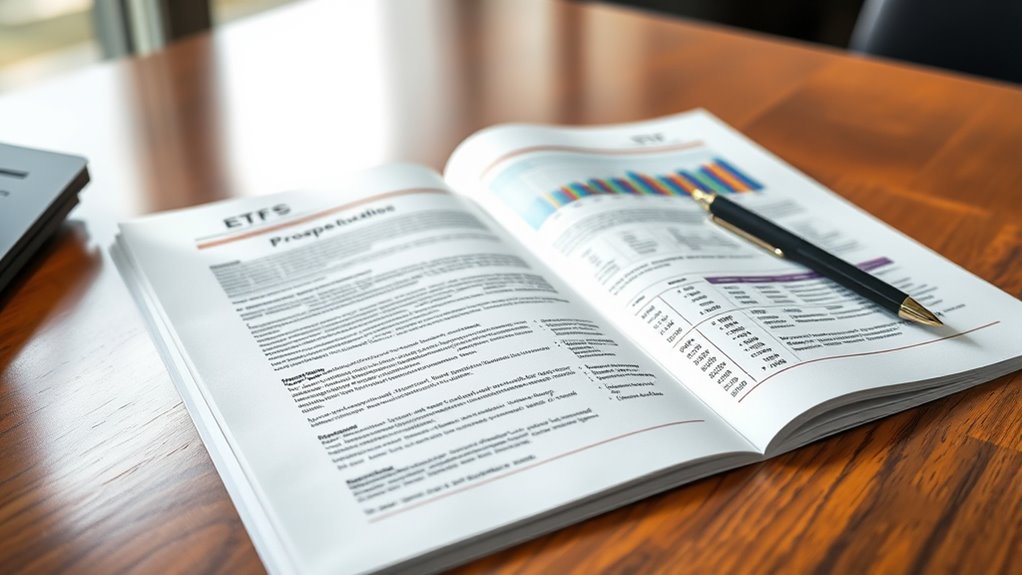To understand an ETF prospectus, focus on sections about risk factors and fees. Look for potential threats like market swings, sector-specific risks, or currency issues to see how they might affect your investment. Also, check the fee structure for management costs, expense ratios, and hidden charges, as these impact your returns. By examining these parts carefully, you’ll be better prepared to make informed decisions about whether the ETF fits your goals. Keep going to learn more.
Key Takeaways
- Focus on the risk factors section to understand potential market, sector, and external risks affecting the ETF.
- Review the fee structure details, including expense ratios and hidden costs, to evaluate cost efficiency.
- Examine the investment objectives and strategies to ensure they align with your financial goals.
- Assess the fund’s holdings and sector exposures for diversification and sector-specific risks.
- Compare risk and fee information across ETFs to determine the most suitable option for your risk tolerance and budget.

Have you ever wondered what all those pages in an ETF prospectus really mean? It can seem overwhelming at first, but understanding the core sections helps you make informed decisions. One of the most important parts to focus on is the risk factors. This section outlines all potential risks associated with the ETF, such as market volatility, liquidity concerns, and sector-specific threats. It’s essential because it gives you a realistic picture of what could go wrong and how the ETF might perform under different conditions. Don’t dismiss this section as mere legal jargon; instead, read it carefully to assess whether the ETF’s risk profile aligns with your investment goals and risk tolerance. For example, if the ETF invests heavily in emerging markets, the risk factors might include political instability or currency fluctuations. Recognizing these risks helps you avoid surprises and prepares you to manage your investments wisely. Additionally, understanding the diversity of holdings within an ETF can help you evaluate how well the fund’s exposure matches your investment strategy.
Equally important is understanding the fee structure. The prospectus clearly states all costs associated with owning the ETF, including expense ratios, management fees, and any additional charges. These fees directly impact your returns over time. A low expense ratio often indicates a more cost-effective fund, but it’s essential to compare this with other similar ETFs. Keep in mind that some ETFs might have hidden fees or trading costs not immediately obvious. The prospectus provides detailed explanations, so take the time to review them thoroughly. Knowing the fee structure helps you evaluate whether the ETF fits within your budget and investment strategy. For instance, a higher fee might be justified if the fund offers specialized management or unique exposure, but for passive index funds, lower fees are usually preferable.
Getting comfortable with these sections means you’ll be better equipped to gauge the overall quality of an ETF. When you read the risk factors, you gain insight into what could threaten your investment’s growth. When you understand the fee structure, you see how much of your returns will be eaten up by costs. Both are essential for comparing different ETFs and selecting the ones that best match your financial goals. Remember, the prospectus isn’t just a legal document—it’s a tool to educate yourself about the investment’s potential and pitfalls. Taking the time to analyze these parts will empower you to make smarter, more confident choices, ensuring your investment journey is as successful as possible.
Frequently Asked Questions
How Often Is an ETF Prospectus Updated?
You should check an ETF prospectus at least once a year, but updates can happen more frequently, especially if there are changes in investment strategies or tax considerations. Fund providers issue new prospectuses when significant modifications occur, so stay vigilant. Regularly reviewing these updates helps you understand how the ETF’s investment approach and tax implications might affect your financial goals, ensuring your investment decisions remain informed and aligned with your strategy.
What Are the Risks Specific to ETFS?
Are you aware of the risks specific to ETFs? You face investment diversification risks if the ETF’s holdings don’t match your goals, and liquidity risks if you can’t buy or sell shares easily. ETFs are generally flexible, but market volatility can impact their value. Always consider these risks alongside your investment strategy, so you can manage potential losses and make informed decisions in fluctuating markets.
How Do Expense Ratios Impact Returns?
Expense impact directly affects your return analysis because higher expense ratios eat into your gains over time. When you invest in an ETF, lower expenses mean more of your money stays invested, increasing potential returns. Always compare expense ratios because even small differences can considerably influence long-term performance. By understanding how expense impact works, you can make smarter investment choices and optimize your returns, ensuring your money grows more efficiently.
Can I Buy ETFS Through Retirement Accounts?
Yes, you can buy ETFs through retirement accounts like IRAs and 401(k)s. Doing so can offer tax advantages, such as tax-deferred growth or tax-free withdrawals, depending on the account type. Incorporate ETFs into your investment strategies to diversify and manage risk. Keep in mind the potential tax implications of trading within these accounts, and always align your choices with your long-term financial goals.
What Should I Do if I Disagree With the Prospectus?
If you disagree with the prospectus, you should review the disclosure requirements carefully and consider how they impact your investor rights. You can contact the ETF provider to seek clarification or express concerns. If your issues remain unresolved, you might want to consult a financial advisor or consider choosing another ETF that better aligns with your investment goals. Remember, understanding your rights helps you make informed decisions.
Conclusion
Think of the ETF prospectus as your map through a complex landscape. By understanding its symbols and signs, you gain the power to navigate with confidence, spotting opportunities and avoiding pitfalls. Remember, every detail is a clue guiding you toward smarter investments. With this knowledge, you hold the key to revealing the true potential of your financial journey—turning the page from uncertainty to clarity, and ultimately, to success.









